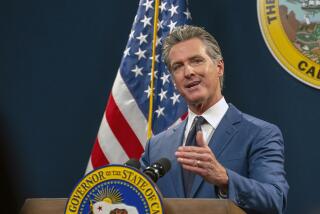Bush Again Unveils Job-Training Plan
- Share via
FRASER, Mich. — Seeking again to cast himself as an agent of change, President Bush used a trip to Michigan on Wednesday to unveil a government reform proposal for the second time in three months.
A White House fact sheet touted the event as Bush’s announcement that he would “transmit to Congress upon its return” the plan for consolidating federal job-training programs.
But the unabashed repackaging of an initiative first made public in January left little doubt about Bush’s determination to drive home an election-year theme of dissatisfaction with the status quo.
Robert S. Teeter, Bush’s campaign chairman, defended the reprise presentation as a way to call attention to a domestic-policy message the White House believes has been too often ignored.
“There is nothing cynical about talking about what you’re doing as President one time or five times or 20 times,” he said. “There is no one-time-only rule, and there shouldn’t be.”
In touting his job-training proposals, Bush said the two pieces of legislation he will submit to Congress when it returns from its two-week recess would “disentangle the knot” of federal job-training programs, which he described as a “crazy quilt of good intentions.”
But the initiative calls for no overall increase in the budget for programs on which the federal government spends $18 billion a year. Only about $110 million is reallocated from one program to another, including a much-touted plan to provide $250,000 grants to California and five other states that in California would amount to less than a penny for each resident.
Nearly all the details of the program were announced by the White House on Jan. 17, but the that announcement received little press coverage.
Domestic policy adviser Roger B. Porter insisted to reporters aboard Air Force One that the second unveiling offered “an additional level of detail . . . meat on the bones.”
Still, Porter and other Administration officials traveling with Bush offered contradictory explanations as to how the program would be financed. A White House fact sheet said the main provisions of the Bush plan designate $50 million for new job-training programs and $55 million for apprenticeship programs for high school juniors and seniors.
But a White House spokesman, Gary Foster, acknowledged late in the day that those sums had been included in the 1993 budget that the White House submitted to Congress earlier this year. An additional $4 million to be awarded to target states and localities is included in the current Labor Department budget, he said.
Bush announced his plan to send the job-training proposal to Congress during a speech at a non-union factory here in Macomb County, a section of suburban Detroit where Democratic voters formed an important bloc of support for President Ronald Reagan.
Campaign chairman Teeter described that region as an ideal place for the announcement because the troubles of American auto manufacturers have displaced many workers there.
Teeter and other senior advisers have also assigned a high priority to persuading those Reagan Democrats to vote Republican again, and Bush’s appearance served as an unmistakable step in an effort to consolidate that electoral base for his reelection.
In his address to employees and invited guests at the Giddings & Lewis plant, which builds machines that make auto parts, Bush also appealed to local sentiment as he reiterated his opposition to any toughening of automobile fuel-economy standards.
Although his speech was described in advance as a standard presidential event, its costs were borne by Bush’s reelection campaign because the President’s principal reason for traveling to Michigan was to attend a political fund-raising dinner.
More to Read
Get the L.A. Times Politics newsletter
Deeply reported insights into legislation, politics and policy from Sacramento, Washington and beyond. In your inbox twice per week.
You may occasionally receive promotional content from the Los Angeles Times.










